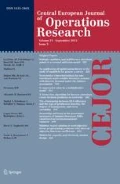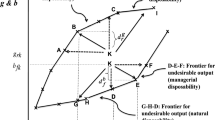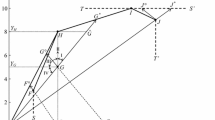Abstract
In data envelopment analysis for environmental performance measurement the undesirable outputs are taken into account. Ones of the standard approaches for dealing with the undesirable outputs are the hyperbolic and the directional distance measures. They both allow a simultaneous expansion of desirable outputs and a contraction of undesirable outputs by means of a single parameter. To meet environmental requirements, a technology with no disposability of undesirable outputs is often considered and the outputs are assumed to be only weakly disposable. We show that the combination of this type of technology with the hyperbolic measure, (or with its linearization, which is a special type of the directional distance model) may lead to a misleading efficiency score of the unit under evaluation. We derive the dual of the hyperbolic model under the environmental technology and describe some of its properties. Then, we use the hyperbolic and directional distance dual models for developing a second-phase method. This enables to detect the misleading scores of the decision making units. We illustrate the results on a real world data set.

Similar content being viewed by others
Notes
Even in this journal a number of interesting papers has been published recently, where some modifications of the basic models are used in various applications. For example, the two-stage output oriented SBM model with restriction on weights is used in evaluation of countries in olympic games by Jablonsky (2018), an input oriented BCC model is modified to select most efficient information system projects in Toloo et al. (2018), and a modification of the output oriented BCC model is employed to assess impacts of environmental regulations on Indian cement industry in Bandyopadhyay (2010).
We use an extension of the notion of Pareto-Koopmans efficiency to technologies with undesirable outputs described e.g. in Scheel (2001).
An output correspondence \(P(\mathbf{x})\) of the technology set is and alternative way of representation and it is joined with the technology \({{\mathcal {T}}}\) with the equivalence relation \((\mathbf{x},\mathbf{b},\mathbf{y})\in {{\mathcal {T}}} \ \Leftrightarrow \ (\mathbf{b},\mathbf{y})\in P(\mathbf{x})\).
We formulate programs equivalent to the maximization programs introduced in Färe et al. (1989).
Färe et al. (1989) use a different linear approximation \(\frac{1}{\theta }\approx 2-\theta \).
The trace \(tr(\mathbf{P}{} \mathbf{Z})\) represents an inner product in the vector space of symmetric \(2\times 2\) matrices.
See the duality theory for semidefinite programming presented for example in Todd (2001).
The proof of this assertion follows the same pattern as the proof of similar result for the Russell measure model in Halická and Trnovská (2018).
The MIP and the weighted additive models provide the technical inefficiency measure IM being equal zero for an efficient DMU. By the associated efficiency measure we understand \(1- IM\).
References
Alizadeh F, Haeberly J-PA, Overton ML (2006) Primal–dual interior-point methods for semidefinite programming: convergence rates, stability and numerical results. SIAM J Optim 8:746–768
Allen K (1999) DEA in the ecological context—an overview. In: Westermann G (ed) Data envelopment analysis in the service sector. Gabler, Wiesbaden, pp 203–235
Bandyopadhyay S (2010) Effect of regulation on efficiency: evidence from Indian cement industry. CEJOR 18:153–170
Banker RD, Charnes A, Cooper WW (1984) Some models for estimating technical and scale inefficiencies in data envelopment analysis. Manag Sci 30:1078–1092
Boyd GA, Mc Clelland JD (1999) The impact of environmental constraints on productivity improvement in integrated paper plants. J Environ Econ Manag 38:121–142
Boyd S, Vandenberghe L (2004) Convex optimization. Cambridge University Press, Cambridge
Boyd GA, Tolley G, Pang J (2002) Plant level productivity efficiency and environmental performance of the container glass industry. Environ Resource Econ 23:29–43
Charnes R, Cooper WW, Rhodes E (1978) Measuring efficiency of decision making units. Eur J Oper Res 2(6):428–449
Chen Ch-M, Delmas MA (2012) Measuring eco-inefficiency: a new frontier approach. Oper Res 60:1064–1079
Chung YH, Färe RS, Grosskopf S (1997) Productivity and undesirable outputs: a directional distance approach. J Environ Manag 51:229–240
Cooper WW, Park KS, Pastor JT (1999) RAM: a range adjusted measure of inefficiency for use with additive models, and relations to other models and measures in DEA. J Prod Anal 11:5–42
De Witte K, Marques RC (2010) Influential observations in frontier models, a robust non-oriented approach to the water sector. Ann Oper Res 181:377–392
Färe RS, Grosskopf S (2003) Nonparametric productivity analysis with undesirable outputs: comment. Am J Agric Econ 85:1070–1074
Färe RS, Grosskopf S (2004) Modeling undesirable factors in efficiency evaluation: comment. Eur J Oper Res 157:242–245
Färe RS, Shephard RW (1974) The law of diminishing returns. Zeitschrift fr Nationalkonomie (J Econ) 34(1/2):69–90
Färe RS, Grosskopf S, Lovell CAK (1985) The measurement of efficiency of production. Kluwer, Boston
Färe RS, Grosskopf S, Lovell CAK, Pasurka CA (1989) Multilateral productivity comparisons when some outputs are undesirable: a nonparametric approach. Rev Econ Stat 71:90–98
Färe RS, Grosskopf S, Pasurka CA (2001) Accounting for air pollution emissions in measures of state manufacturing productivity growth. J Reg Sci 41:381–409
Färe RS, Grosskopf S, Noh D, Weber W (2005) Characteristics of a polluting technology: theory and practice. J Econom 126:469–492
Färe RS, Grosskopf S, Pasurka CA (2007) Environmental production functions and environmental directional distance functions. Energy 32:1055–1066
Färe RS, Margaritis D, Rouse P, Roshdi I (2016) Estimating the hyperbolic distance function: a directional distance function approach. Eur J Oper Res 254:312–319
Grant MC, Boyd SP (2008) Graph implementations for nonsmooth convex programs. In: Blondel VD, Boyd SP, Kimura H (eds) Recent advances in learning and control. Lecture notes in control and information sciences, vol 371. Springer, London, pp 95–110
Grant M, Boyd S (2013) CVX: Matlab software for disciplined convex programming, version 2.0 beta. http://cvxr.com/cvx. Accessed 12 Sept 2017
Hailu A, Veeman TS (2001) Non-parametric productivity analysis with undesirable outputs: an application to the canadian pulp and paper industry. Am J Agric Econ 83:605–616
Halická M, Trnovská M (2018) The Russell measure model: computational aspects, duality, and profit efficiency. Eur J Oper Res 268:386–397
Hernandez-Sancho F, Picazo-Tadeo A, Reig-Martinez E (2000) Efficiency and environmental regulation: an application to Spanish wooden goods and furnishing industry. Environ Resour Econ 15:365–378
Jablonsky J (2018) Ranking of countries in sporting events using two-stage data envelopment analysis models: a case of Summer Olympic Games 2016. CEJOR. https://doi.org/10.1007/s10100-018-0537-8
Kao C (2017) Network data envelopment analysis. Springer, Berlin
Korhonen PJ, Luptacik M (2004) Eco-efficiency analysis of power plants: an extension of data envelopment analysis. Eur J Oper Res 154:437–446
Kortelainen M, Kuosmanen T (2004) Data envelopment analysis in environmental valuation: environmental performance, eco-efficiency and cost-benefit analysis. Discussion paper no. 21, Department of Business and Economics, University of Joensuu. http://epublications.uef.fi/pub/urn_isbn_952-458-528-6/urn_isbn_952-458-528-6.pdf. Accessed 30 Apr 2018
Kumar S (2006) Environmentally sensitive productivity growth: a global analysis using Malmquist-Luenberger index. Ecol Econ 56:280–293
Kuosmanen T (2005) Weak disposability in nonparametric production analysis with undesirable outputs. Am J Agric Econ 87:1077–1082
Lee JD, Park JB, Kim TY (2002) Estimation of the shadow prices of pollutants with production environment inefficiency taken into account: a nonparametric directional distance function approach. J Environ Manag 63:365–375
Meng F, Su B, Thomson E, Zhou D, Zhou P (2016) Measuring China’s regional energy and carbon emission efficiency with DEA models: a survey. Appl Energy 183:1–21
Picazo-Tadeo AJ, Reig-Martínez E, Hernández-sancho R (2005) Directional distance functions and environmental regulation. Resour Energy Econ 27:131–142
Ray S, Mukherjee K (2007) Efficiency in managing the environment and the opportunity cost of pollution abatement. Working papers 2007–2009. University of Connecticut, Department of Economics. http://digitalcommons.uconn.edu/econ_wpapers/200709/. Accessed 26 Sept 2017
Sahoo BK, Luptacik M, Mahlberg B (2011) Alternative measures of environmental technology structure in DEA: an application. Eur J Oper Res 215:750–762
Scheel H (2001) Undesirable outputs in efficiency valuations. Eur J Oper Res 132:400–410
Seiford LM, Zhu J (2002) Modeling undesirable factors in efficiency evaluation. Eur J Oper Res 142:16–20
Shepard RW (1970) Theory of cost and production functions. Princeton University Press, Princeton
Sturm JF (1999) Using SeDuMi 1.02, a MATLAB toolbox for optimization over symmetric cones. Optim Methods Softw 11:625–635
Sueyoshi T, Sekitani K (2007) Computational strategy for Russell measure in DEA: second-order cone programming. Eur J Oper Res 180:459–471
Todd MJ (2001) Semidefinite optimization. Acta Numer 10:515–560
Toloo M, Nalchigar S, Sohrabi B (2018) Selecting most efficient information system projects in presence of user subjective opinions: a DEA approach. CEJOR. https://doi.org/10.1007/s10100-018-0549-4
Valadkhani A, Roshdi I, Smyth R (2016) A multiplicative environmental DEA approach to measure efficiency changes in the world’s major polluters. Energy Econ 54:364–375
Wu CH, Chang CC, Chen PC, Kuo KN (2013) Efficiency and productivity change in Taiwan’s hospitals: a non-radial quality-adjusted measurement. CEJOR 21:431–453
Wu J, Zhou Z, Kong Y (2014) The environmental efficiency of Chinese paper mills along Huai River: a DEA study. Environ Eng Manag J 13:1101–1109
Zaim O, Taskin F (2000a) Environmental efficiency in carbon dioxide emissions in the OECD: a non-parametric approach. J Environ Manag 58:95–107
Zaim O, Taskin F (2000b) A Kuznets curve in environmental efficiency: an application on OECD countries. Environ Resour Econ 17:21–36
Zhang N, Choi Y (2014) A note on the evolution of directional distance function and its development in energy and environmental studies 1997–2013. Renew Sustain Energy Rev 33:50–59
Zhou P, Ang BW, Poh KL (2008) A survey of data envelopment analysis in energy and environmental studies. Eur J Oper Res 189:1–18
Zhou H, Yang Y, Chen Y, Zhu J (2018) Data envelopment analysis application in sustainability: the origins, development and future directions. Eur J Oper Res 264:1–16
Acknowledgements
The authors are thankful to Israfil Roshdi for sharing the dataset for 92 coal-fired power plants, and three anonymous reviewers for comments. Research of the authors was supported by VEGA Grant 01/0062/18.
Author information
Authors and Affiliations
Corresponding author
Rights and permissions
About this article
Cite this article
Halická, M., Trnovská, M. Negative features of hyperbolic and directional distance models for technologies with undesirable outputs. Cent Eur J Oper Res 26, 887–907 (2018). https://doi.org/10.1007/s10100-018-0567-2
Published:
Issue Date:
DOI: https://doi.org/10.1007/s10100-018-0567-2




